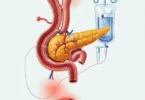Insulin
The peptide hormone insulin regulates the uptake of glucose in cells. It produce hypoglycemic effect and plays an essential role in the therapy of diabetes mellitus. Insulin is the natural opponent of the hormone glucagon.
The name insulin comes from the islet cells of the pancreas (pancreatic) that make up the insulin.
Biochemistry Of Insulin
Insulin is a macromolecule with a molecular weight of about 5,700 Dalton. It consists of 2 longer polypeptides, an A chain with 21 amino acids and a B chain with 30 amino acids. The two chains are connected to each other by disulfide bridges ehich are formed between the cysteine . A third disulfide bridge is within the A-chain. It help in stabilizing the spatial structure.
Due to the formation of hydrogen bonds between the oxygen atoms of the carbonyl groups and the hydrogen atoms of the amide groups of the two polypeptide chains createdthe secondary structure of insulin. The molecular chains pull helically together. The A-chain forms 2 α helices, which are separated by an amino acid building block. The B-chain wraps itself about 40% on an α-helix.
Effects
Insulin has hypoglycemic properties. The hormone has many effects in carbohydrate, fat and protein metabolism. It promotes anabolic processes and inhibits catabolic:
Carbohydrate metabolism:
Inhibition of hepatic glucose production (gluconeogenesis)
Stimulating the uptake of glucose into muscle and fat tissue
Promote the consumption of glucose (glycolysis)
Promote development of glycogen
Fat metabolism:
Promote development of triglycerides (lipogenesis)
Inhibiting the degradation of triglycerides (lipolysis)
Reduction of free fatty acids
Protein metabolism:
Stimulating the uptake of amino acids into cells (eg in muscle tissue)
Stimulation of protein synthesis
Inhibiting the degradation of proteins (proteolysis)
Inhibiting gluconeogenesis by inhibiting degradation of free amino acids
Short-Acting Insulins
They cover the need for insulin at mealtimes (bolus). They work more quickly and has a effect shorter (more than six hours) than that of the long-acting insulins. In addition, elevated blood sugar levels is corrected with them.
Human insulins:
These insulins are identical in construction to the insulin formed by the human pancreas. They are mainly produced by genetic engineering with the aid of bacteria or yeasts. The effect is begin after 30 minutes and reached at maximum level after two hours and it end after 4 to 5 years.
Insulin analogs:
These are slightly modified insulins and genetically compared with human insulin. Insulin analogues act much faster and also shorter than human insulins. Thus blood sugar is better control with this. They are also called “turbo insulins”. The effect begins after a few minutes, the maximum is reached after just one hour and after 2 .5 to 3 hours it will ends. In this way, blood sugar increases after meals are better avoided and also reduced severe hypoglycaemic reactions due to insulin action between meals. The mode of action corresponds to body’s own insulin is significantly better . A time interval between injection and meal is not required
Long-Acting Insulins
They are also called basal insulins. They have a duration of action up to 24 hours, older and hardly common insulins even up to 36 hours.
Intermediate-Insulin (Insulin):
Human insulin whose onset and duration will be delayed by the addition of certain substances. Their duration of action is depending on dose. The action does not run smoothly. It begins after about two hours, reached maximum after four to six hours and then decreases. Since most diabetics inject insulin only at night, the maximum effect makes them particularly noticeable in the deep hours of the night. Here lies the danger of nocturnal hypoglycemia. As part of the dose user should be paid particular attention to the blood glucose values between 2.00 and 3.00 clock.
The binding of insulin to the protein protamine arise NPH insulins. They are the standard insulin to cover the needs of food independent insulin.The effect occurs after two hours of the injection, the maximum effect is achieved after about 4 to 6 hours and the duration of action is from 8 to 12 hours.
Long Acting Insulin Analogues:
You have to injected only once in a day, because their effect lasts up to 24 hours. Unlike the Intermediate-insulin they act uniformly over the entire period and ideally have no so pronounced maximum effect as the NPH insulin. You must not be swiveled. Today often the insulin analogues Detemir and Glargine are used as basal insulins. Both reduce the risk of nocturnal hypoglycemia.
Mixed Insulins
They contain a short and a long-acting insulin. They are available in different mixing ratios (eg: 30/70 = 30 percent fast-acting insulin, 70 percent of long-acting insulin). The share of short-acting insulin is approximately between 25 and 50 percent. They are especially for people with type 2 diabetes likely to have a regular daily routine with solid food and travel times and consistent food choices every day.






